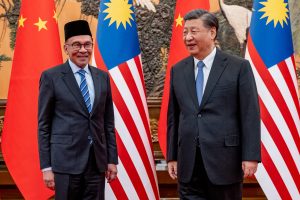China’s leader Xi Jinping will reportedly embark on a three-nation tour of Southeast Asia later this month, a possible sign that China is seeking to capitalize on the current regional unease about the direction of U.S. policy in the region.
On Monday, the South China Morning Post, citing unnamed diplomatic sources, reported that Xi will travel to Vietnam, Malaysia, and Cambodia sometime in mid-April. The tour would mark Xi’s first overseas visit of the year, and his first visit to Southeast Asia since his state visit to Vietnam in December 2023.
The trip comes at a time of great regional uncertainty about U.S. policy toward Southeast Asia, as the Trump administration shreds bipartisan foreign policy assumptions and engineers a significant reorientation of American priorities.
In an article last month, Ben Bland, the director of the Asia-Pacific Programme at Chatham House, argued that the early stages of Trump’s second administration was “simply reinforcing their worst pre-existing suspicions about America” as a coercive and erratic power. “Trump, as they see it, is simply a more disruptive and shameless version of those who came before him in the White House,” he wrote.
As such, it is very likely that Xi will use the opportunity of this upcoming trip to depict China as a steadfast and reliable partner, and to contrast this with the increasingly erratic and episodic nature of U.S. engagement with the region. This, in turn, would reinforce Beijing’s long-standing message to Southeast Asia: that despite occasional periods of tension, it is a geopolitical reality in the region in a way that the U.S. is not.
Posting on X, Susannah Patton of Sydney’s Lowy Institute observed that the choice of destinations for the trip may reflect a sense of “geopolitical opportunity” on Xi’s part. She pointed out that both Vietnam and Malaysia are currently running large trade surpluses with the U.S., and fear the possible imposition of tariffs by the Trump administration. Cambodia, meanwhile, is arguably China’s closest partner in the region, one that needs an injection of Chinese investment to stave off an economic slump.
In terms of U.S. tariffs, Vietnam has a particular reason for unease, given the size of its $123.5 billion trade surplus with the U.S., which grew by nearly a fifth in 2024. It is now the third-largest in the world, behind the surpluses enjoyed by China and Mexico. Malaysia probably has less to worry about on this front. While it is currently running a $24.8 billion trade surplus with the U.S., this fell by $2.1 billion (or 7.6 percent) over 2023, according to the Office of the U.S. Trade Representative. This is the third-largest surplus among ASEAN member states (and the 14th overall), though it also lags behind the surpluses enjoyed by Taiwan, Japan, and South Korea.
It is also true that despite their unresolved disputes in the South China Sea, Malaysia and Vietnam currently enjoy good relations with China. Prime Minister Anwar Ibrahim has visited China three times since taking office in late 2022, most recently in November. The SCMP reported that the Chinese leader would likely spend three days in Malaysia, which would build on November’s “productive” meeting.
In August, shortly after his appointment as general secretary, To Lam, the head of the Communist Party of Vietnam, also made Beijing the destination of his first overseas trip as party chief, in line with established Vietnam custom. As Khang Vu wrote in these pages at the time, the visit, during which both leaders went out of their way to state that they viewed their bilateral relations as a “priority,” reflected the close mutual understanding between Beijing and Hanoi. The Vietnamese parliament also recently approved an $8 billion rail link from the northern port of Haiphong to the Vietnam-China border gate at Lao Cai-Hekou, via the capital Hanoi.
Xi’s visit to Cambodia, meanwhile, would function as a form of diplomatic maintenance for a bilateral relationship that is among China’s strongest in the Asia-Pacific. Xi has not visited the country since 2016, and his upcoming trip would be the first since Prime Minister Hun Manet succeeded his father, Hun Sen, in 2023. According to a report by Nikkei Asia, Xi will likely take the opportunity to highlight China’s development assistance to the country, in the wake of the Trump administration’s sweeping foreign aid cuts. In recent weeks, as the U.S. cuts have forced the cancellation of aid projects in Cambodia, in the areas of child healthcare, nutrition, sanitation, and land mine clearance, the Chinese government has stepped into the breach, announcing similar projects of its own.
In this context, it is only natural that Xi would seek to maintain the current momentum in these bilateral relationships, while presenting his Southeast Asian interlocutors with a contrast to the chaos and disruption that are currently playing out in Washington. So far, in its attempts to revolutionize both U.S. domestic politics and American foreign policy, the Trump administration is making it all too easy for him.

































